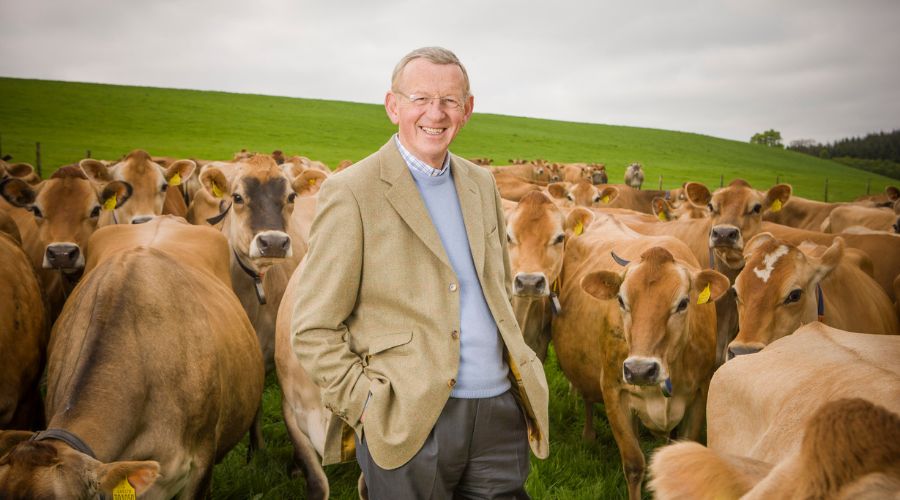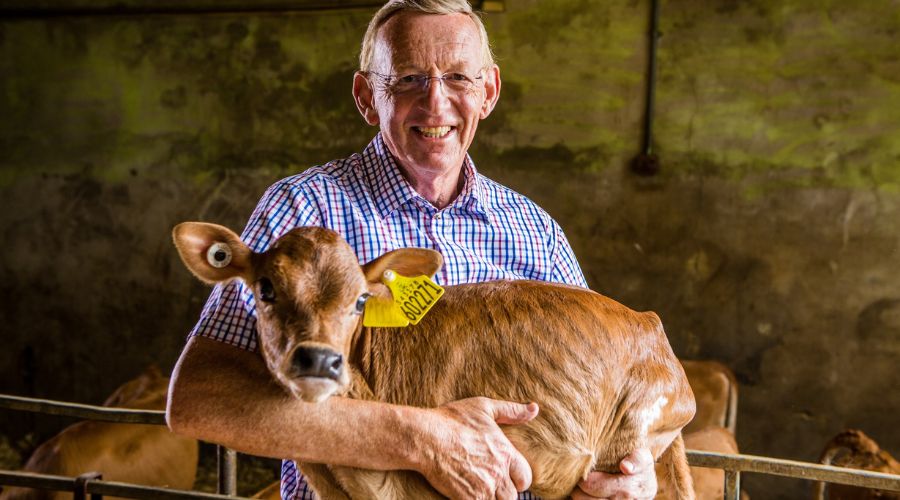Jersey cows: Doing things differently
31st July 2024
Having bought their first Jersey herd from the late Queen Elizabeth II, Graham’s Family Dairy has since seen huge demand for its Jersey milk products.

The Graham family’s Jersey journey started in 1992, when all their milk was coming from Holsteins – but Dr Robert Graham says he wanted to do something different.
“We were renting land at what is now the University of Stirling campus, when the Scottish Government decided that the new university would be built, we slowly but surely had to move on,” he explains.
“We didn’t then have enough land to sustain what was around 100 black and white cows then so we purchased a dairy farm called Boquhan farm – which we have to this day.”
The new land gave them an opportunity to do something different.
“Everyone produced milk from black and white cows at the time but there weren’t many people with Jersey cows.
“I was told at the time that the Queen herself had a herd of about 20 Jerseys and before I knew it, I had travelled to Windsor to buy the cows directly from the Queen,” he remembers.
“We brought them back to the new farm thinking… how are we going to sell this stuff?”
Graham’s Family Dairy is Scotland’s largest independent dairy – founded in 1939 in Stirlingshire, it now produces a wide range of award-winning dairy products.
Creamier milk
They came up with the idea that they would process the milk as normal and sell it as ‘Graham’s Breakfast Milk’.
“The creamier Jersey milk is ideal for breakfast and porridge in the morning and that’s what people used it for.
“The demand continued as no one else was making milk like it.
“The product slowly evolved to become ‘Graham’s Gold Top’, and we continued to expand our herd of Jerseys to today where we have around 300 and continue to see huge demand for the great milk they produce.”
They also have another 600 female Jerseys aged 0-2 waiting in line to succeed the current herd of milkers.
The family has around 700 acres of land owned, and 380 rented – mostly for grazing, silage and hay. Keeping it as simple as possible is the farm’s strategy, and Robert says they are lucky to have “brilliant” farm managers.
READ MORE: 80s fridge staple proves to still be popular choice among British shoppers
Lighter on their feet, higher butterfat
The Grahams farm on the carse of Stirling, which is very flat all the way out to the valley.
Jersey cows are much lighter on their feet than Holsteins, so they can be put out to grass a bit earlier and kept out a bit later at the back end of the year, Robert explains. Plus, they don’t churn up the fields as much as black and white cows.
Jersey milk is also much more versatile.
“You can make good ice cream and really good cream. Jersey cows are higher in butterfat – a normal cow you may find around 3.8%, whereas on a Jersey cow you’re closer to around 6%.
“We can then start standardising the milk, so we can take some of the cream off and use that cream for butter and other cream products.
“Even after that, you’re still left with a milk that has 5% butterfat that has great taste.”
It was important to diversify their products and Jersey cows have allowed them to do something different from others in the industry, while giving customers more options.

Adaptable, but tenacious
Asked about the downsides of the breed, Robert says there aren’t really any. “Jersey cows are very adaptable and have strong personalities. Although they are small, they are very hardy.”
He adds: “Lots of Jerseys now are being exported abroad, even as far as the Middle East, because of their ability to adapt.
“Cows can withstand extreme heats and extreme colds. A classic Holstein cow, they do not like the cold and when they are cold their milk production drops as they are using so much energy to keep their body warm.
“You don’t have that with Jerseys, they have some sort of resilience that other breeds just don’t have.”
One small challenge, however, is they have to be farmed alone, without other breeds.
“That tough personality they have means that they can bully the black and white cows a wee bit. They are that much smaller that if there is feed, they will be able to bustle their way in there. They have that tenacity,” Robert acknowledges.
High demand
Another challenge for the farm is the pure demand for Gold Top milk.
“Every single week, we are dealing with huge demand and that brings with it its own challenges.
“Holsteins are bigger so they produce more physical milk than Jerseys so we are constantly looking to grow our herd to keep up with the growing desire for Gold Top,” Robert says.
READ MORE: Latest report calls 2023/23 a ‘mixed year’ for UK dairy farms
Challenging times
So could Jerseys meet the needs of farmers going forward? Not solely, Robert admits.
“Being honest, I don’t think any breed solely meets the needs of the farmer going forward.
“By taking away single farm payments, one of the main actions farmers will need to take to survive is to put milk prices up a lot higher – neither the farmer or the consumer want that.”
As well as challenging legislation, climate conditions mean cows are housed for longer than they used to be.
“In the past, we would put cows out to grass in April and bring them back inside in September. This year, with storms and flooding, it’s the beginning of June they’re out.
“As soon as you see your cows standing below the trees to hide from the rain, you know they are not producing enough milk and that they are much happier inside. Every farmer is juggling economically and environmental challenges.”
Changing trends
The farm’s most popular liquid product is their Gold Top milk, and this has been consistently so over the years.
“The growth in Gold Top is just massive, we have seen a 15% increase in sales and volumes in the last year, with no signs of slowing. We are now processing and selling over 1 million litres of gold milk every month,” Robert says.
They work seven days a week to get the Jersey milk produced, bottled and available to buy – for all other liquid products they work six days a week.
The continued demand for Gold Top matches the market trends across the board, Robert notes.
“Consumers want to purchase high-quality tasting products with more protein in them.
“Our Gold Top milk has a higher protein count than our classic milk from Holstein cows, so people are naturally gravitating towards drinks that have that higher protein.”
Graham Family Dairy has also seen a boom in its protein products, including its Protein 25 drinks and pouches.
“Our sales for protein and Skyr products overtook sales of classic milk in supermarkets and now our high protein products sales now make up more than a quarter of the business’ total sales,” he adds.
Trends come full circle too, and consumers are now buying full fat milk over semi skimmed again – and cottage cheese sales have risen by 40% on last year. “It’s crazy to see how the trends are always evolving,” he adds.
Read more dairy news.
